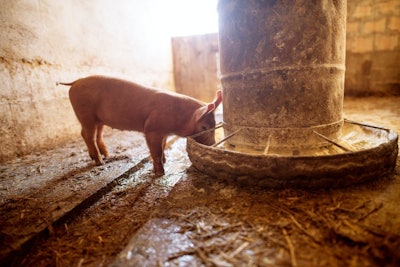
Designing a high-quality piglet feed requires attention and knowledge for each ingredient and nutrient involved.
Feeding weaned pigs remains a challenge – not because we lack the supporting science, technology and experience to provide adequate nutrition and feeds to recently weaned pigs. In fact, the whole field of piglet nutrition has made great leaps in the past 30 years to the point we can safely declare that post-weaning feed anorexia – or refusal to eat dry feed – is no longer an issue. That is, at least, in theory and in many advanced farms that follow correct procedures.
Lamentably the majority of farms – and here I am pointing towards mega farms that often lack the appropriate labor skills, mindset or even inclination – do not seriously consider the lifelong implications of a wrong start early in life.
It has been decades since have established that piglets that consume an average of about 200 grams per day during the first week post-weaning will reach market weight at least 10 days earlier, or reach marketing age with 10 extra kilograms body weight. This may be an oversimplification, but it is a good rule of thumb to evaluate any piglet feeding program. I should mention that farm size does not always dictate piglet nutrition philosophy as many even small producers tend to ignore piglet nutrition.
The real problem that we have not overcome, as an industry, is that piglet feed is seen as a cost – and an expensive one at that – instead of an investment. When pig feed, in general, costs less than 300 euros (or USD) per metric ton (or U.S. ton), then it becomes difficult to sell a feed that starts at 1,500 euros per metric ton and may drop to just less than 1000 euros per metric ton at the end of the nursery phase (weaning to 25 kg body weight). Seen from such perspective, it is clearly an expensive investment, but seen as a cost per pig, it clearly becomes a minor expense, and if we consider lifetime benefits, it is perhaps the best type of investment.
To answer this problem, we must point fingers to ourselves – the animal feed industry – because we have been engaged into a price battle instead of promoting quality and performance.
For those who want to utilize high-quality piglet feeds that can boost piglet lifetime performance, the following aspects should be considered and discussed seriously with an attending nutritionist that has a complete understanding of the farming operation.
Lactose and other simple sugars
Piglets require lactose (or other simple sugars equivalent to lactose) to thrive post-weaning due to their immature digestive system. In healthy animals, the feed intake response to lactose is linear up to 30% dietary lactose. In sick and challenged animals, the response to lactose is not clear and, in fact, too much lactose can lead to secondary gut health implications.
Lactose can be replaced by dextrose, sucrose and molasses. Nevertheless, lactose is a laxative per se and as such it can induce osmotic diarrhea in piglets, especially if feed intake is excessive. As such, scouring piglets should not receive high-lactose diets, and high-lactose diets should, in general, be preserved for piglets right before and after weaning. Ideally, the four days before and after weaning is where the first feed should be directed for best results.
Fiber, now and then
Fiber is generally deemed undesirable in early piglet diets because it reduces feed intake and the digestibility of other nutrients. Most piglet diets should contain less than 3% crude fiber. With the advent of antibiotic-free feeds, some functional fibers can act as prebiotics at the gastrointestinal level, providing substrate for the proliferation of beneficial bacteria. This establishes a healthy microflora excluding most pathogenic bacteria. Sources of functional fibers include beet pulp, chicory pulp and carob meal. These are mainly fermentable fibers acting at the hind gut level. Insoluble fibers are also considered beneficial for the upper digestive tract part as they can act as a way of reducing water leakage and in general aid digestibility, motility and overall gut health.
Energy and lipids
Piglets around weaning time are not able to fully digest animal fats, such as lard and tallow. They benefit from vegetable oils and fats, such as soybean oil and especially coconut fat. Piglet diets should be rich in energy because at weaning animals are in a negative energy state due to low feed intake. As such, weaning diets should contain about 11 MJ NE/kg, dropping to about 10 MJ NE/kg at the time of exiting the nursery phase. An excellent source of lipids is full-fat soybeans (extruded or otherwise thermally processed). Their lipids are largely inside cells and as such they are not prone to leaking. This enables “high-fat” piglet diets to be formulated with relative ease. Functional lipids (such as sources of omega-3 fatty acids) are considered today as the new frontier in piglet nutrition as they can enhance immune status in the absence of antibiotics.
Protein and amino acids
Piglet diets should contain as little crude protein as possible, especially when diets do not control enough gut microbial controlling agents (such as antibiotics). This is achieved with the use of feed-grade amino acids and the selection of appropriate highly digestible ingredients. High-protein diets reduce the available energy for growth and provide substrate for the proliferation of pathogenic bacteria.
A diet fed immediately post-weaning should contain no more than 20% crude protein, falling to 18% at the end of the nursery period when pigs weigh about 25 kg body weight. It should be noted here that amino acids should be formulated based on an ideal protein profile to enable rapid growth and improved efficiency of feed utilization. In the case of protein sources, we must differentiate between plant-based ones, which often contain high levels of anti-nutritional factors, and animal-based ones that suffer mostly from quality issues due to inappropriate processing.
Immunoglobulins – the expensive ones
Piglet diets are typically fortified with a strong source of immunoglobulins (such as animal plasma, egg proteins or whey proteins) to enhance gastrointestinal health, promote feed intake, and increase growth. Although these kinds of proteins work with great efficiency, they are invariably the most expensive class of ingredients in any piglet feed. As such, their level is often curtailed, often to ineffective concentrations, or not used at all. Other alternatives exist but it is difficult to discern those that work from the many ineffective imitations. In general, the more digestible an early piglet diet and the healthier the animals, the less immunoglobulins are needed in the feed.
Cereals, raw and cooked
It has long been advocated piglets should be fed diets based on cooked cereals post-weaning. Indeed, healthy piglets benefit from the enhanced nutrient digestibility and reduced anti-nutritional factors in thermally processed cereals. Cereals that most benefit from such treatment are wheat and barley.
There is little, if any, evidence suggesting corn requires any thermal treatment when finely ground. Nevertheless, empirical evidence points to the direction of non-cooked (raw) cereals when piglets are susceptible to diarrhea (pathogenic or secretory). As a matter of fact, scouring piglets benefit not only from raw cereals, but also from cereals with elevated crude fiber concentration, and also from coarsely ground cereals.
Soybeans and legumes in general
In general, piglets are affected negatively by almost all legume-derived products because this family of plants contains relatively high concentrations of many and diverse anti-nutritional factors. For piglets and soybeans, the most important one remains the trypsin inhibitor activity anti-nutritional factor. This compound severely decreases protein digestion and absorption of amino acids. To effectively deactivate it, thermal processing is required, but on the other hand, too much heat can actually reduce protein digestibility per se.
To this end, soybean meal (44-48% crude protein) should be used in limited quantities in piglet diets, ranging from 5 to 15% depending on the diet and actual health of the piglets. Full-fat soybeans can be used more liberally, especially if they are of high quality. Finally, soy protein concentrate can be used in higher amounts, but this ingredient is usually too expensive.
Vitamins and all minerals
These have a minor cost but play a crucial role because piglets consume small quantities of feed during the nursery period compared with the overall feed consumption until slaughter. Nevertheless, most piglet feeds are grossly over-fortified in all vitamins, macro- and micro-minerals. Research and practice have suggested lower levels are more economical without sacrificing performance or health.
Specifications published by accredited institutions should be followed as these take into account the above. In general, it is macro-minerals that require the most attention to not exceed certain limits, although the antagonistic relationships among trace minerals should not be ignored.
Additives: expense or investment?
There is a plethora of information on additives for piglets, but it should be remembered that additives should be selected based on the overall diet formulation and animal health/condition. Not all additives are needed all the time for all animals and all kinds of feed formulations. If this rule is not followed, additives can contribute quite heavily on overall cost. A qualified nutritionist should be responsible to select the right additives for the right purpose for each feed and farm specific situation.
In closing
Designing, manufacturing, and marketing a piglet feed remains a challenging job because one must balance quality and performance against cost. Quite often, the issue of cost overweighs everything else. This is why the balance today is toward less expensive, and hence less effective, piglet diets.
Pig producers often complain that piglets continue to suffer post-weaning and the search for a better – but not more expensive – feed continues. Because of this paradox, many piglet feed companies have made or lost tremendous fortunes.













